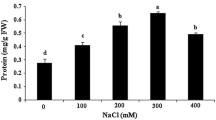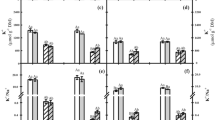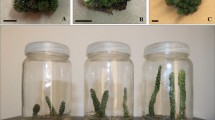Abstract
The effect of exogenous proline (6 mM) and increasing NaCl doses (from 0.4 to 1.2% w/v) on the maintenance of organogenic and embryogenic callus lines derived from the salt-sensitive maize inbred W64Ao2 were studied. To this end, total protein, free amino acid and polyamine content were analyzed. The demand of exogenous nitrogen and especially of proline, even in the presence of salt, differed in the two types of morphogenic calluses. The total protein content of embryogenic calluses was higher in the presence of proline than in its absence, in all the cases studied. An opposite effect of proline was observed in organogenic calluses: the presence of proline and salt decreased significantly their protein content. With respect to amino acid and polyamine contents, the organogenic calluses showed physiological characteristics of salt-adaptation, whereas the embryogenic calluses were more sensitive to NaCl. Although endogenous proline increased in the organogenic calluses cultured in the presence of salt, in embryogenic calluses it only rose at the lowest salt concentration. Furthermore, the endogenous arginine content under saline conditions was higher in organogenic calluses. A compensatory effect between proline and polyamine metabolism related to the endogenous arginine content in response to salt stress was also observed. This effect differed in the two types of calluses.
Similar content being viewed by others
Abbreviations
- Ala:
-
alanine
- Arg:
-
arginine
- 2,4-d :
-
2,4-dichlorophenoxyacetic acid
- EC:
-
embryogenic callus
- GABA:
-
γ-amino butyric acid
- MC:
-
meristematic callus
- PAs:
-
polyamines
- Pro:
-
proline
- Put:
-
putrescine
- Spd:
-
spermidine
- Spm:
-
spermine
References
Aguilar R & Sanchez de Jimenez E (1984) Amino acid pools and protein synthesis in germinating maize embryos. Plant Cell Rep. 3: 193–195
Armstrong CL & Green CE (1985) Establishment and maintenance of friable, embryogenic maize callus and the involvement of l-proline. Planta 164: 207–214
Basu R & Gosh B (1991) Polyammes in various rice genotypes with respect to sodium chloride salinity. Physiol.Plant. 82: 575–581
Bellinger Y, Bensaoud A & Lather F (1991) Physiological significance of proline accumulation, a trait of use to breeding for stress tolerance. In: Acevedo E et al (eds) Physiology- Breeding of Winter Cereals for Stressed Mediterranean Environments (pp 449–458). INRA Paris
Bestford RT, Richardson CM, Capell T & Tiburcio AF (1991) Effect of polyamines on stabilization of molecular complexes in tilacoid membranes of osmotically-stressed oat leaves. In: Tiburcio et al. (eds) Polyamines as Modulators of Plant Development (pp 71–73). Fund. Juan March, Madrid, Spain
Bradford MM (1976) A rapid and sensitive method for the quantification of microgram quantities of protein utilizing the principle of protein-dye binding. Anal Biochem. 72: 248–254
Chu CC, Wang CC, Sun CS, Hsu C, Chu CY & Bi FY (1975) Establishment of an efficient medium for anther culture of rice through comparative experiments on the nitrogen source. Sci. Sin. 18: 659–668
Claparols I, Santos MA & Torné JM (1993) Influence of some exogenous amino acids on the production of maize embryogenic callus and on endogenous amino acid content. Plant Cell Tiss. Org. Cult. 34: 1–11
Di Tomaso J, Shaff JE & Kochian LV (1989) Putrescine-induced wounding and its effects on membrane integrity and ion transport processes in roots of intact corn seedlings. Plant Physiol. 90: 988–995
Duncan DR & Widholm JM (1987) Proline accumulation and its implication in cold tolerance of regenerable maize callus. Plant Physiol. 83: 703–708
Erdei L, Trivedi S & Matsumoto H (1990) Effects of osmotic and salt stress on the accumulation of polyamines in leaf segments from wheat varieties differing in salt and drought tolerance. J. Plant Pysiol. 137: 165–168
Fougere F, Le Rudulier D & Streeter JG (1991) Effects of salt stress on amino acid, organic acid,and carbohydrate composition of roots, bacteroids and cytosol of alfalfa (Medicago sativa). Plant Physiol. 96: 1228–1236
Galston AW & Kaur-Shwhney R (1990) Polyamines in plant physiology. Plant Physiol. 94: 406–410
Kaur-Shawney R, Flores HE & Galston AW (1980) Polyamine induced RNA synthesis and mitosis in oat leaf protoplasts. Plant Physiol. 65: 368–371
Krishnamurthy R & Bhagwat KA (1989) Polyamines as modulators of salt tolerance in rice cultivars. Plant Physiol. 91: 500–504
Krishnamurthy R (1991) Amelioration of salinity effect in salt tolerant rice. Foliar application of putrescine. Plant Cell Physiol. 32: 699–703
Lillo C (1989) Effects of media components and environmental factors on shoot formation from protoplast-derived calli ofSolanum tuberosum. Plant Cell Tissue Organ Cult. 19: 103–111
Lovatt C (1990) Stress alters ammonia and arginine metabolism. In: Flores HE et al. (eds) Polyamines and Ethylene: Biochemistry, Physiology and Interactions (pp 166–179). Amer. Soc. Pl. Physiol. Rockville, Maryland, USA
Lucarini C & Sangwan RS (1987) Changes in polyamines, protein and ionic contents during ‘in vitro’ salt-stressed androgenesis ofNicotiana tabacum. Biochem. Physiol. Pflanzen. 182: 57–66
Murashige T & Skoog F (1962) A revised medium for rapid growth and bioassays with tobacco tissue cultures. Physiol. Plant. 15: 473–497
Pulich WM (1986) Variations in leaf soluble amino acids and ammonium content in subtropical seagrasses related to salinity stress. Plant Physiol. 80: 283–286
Santos MA & Torné JM (1986) A comparative analysis between totipotency and growth environment conditions of the donor plants in tissue culture ofZea mays L. J. Plant Physiol. 123: 299–305
Santos M, Claparols I & Torné JM (1993) Effect of exogenous arginine, ornithine, methionine and γ-amino butiric acid on maize (Zea mays L.) embryogenesis and polyamine content. J. Plant Physiol. 142: 74–80
Slocum RD & Weinstein KH (1990) Stress-induced putrescine accumulation as a mechanism of ammonia detoxification in cereal leaves. In: Flores HE et al. (eds) Polyamines and Ethylene: Biochemistry, Physiology and Interactions (pp 157–167). Amer. Soc. of Plant Physiol., Rockville, Maryland, USA
Smith TA (1985) Polyamines. Ann.Rev.Plant Physiol. 36: 117–143
Thomas JC, De Armond RL & Bohnert HJ (1992) Influence of NaCl on growth, proline and phosphoenolpyruvate carboxylase levels inMesembryanthemum crystallinum suspension cultures. Plant Physiol. 98: 626–631
Thompson JF (1980) Arginine synthesis, proline synthesis and related processes. In: Stumpfet et al. (eds) (Vol.5 pp 375–402). The Biochemistry of Plants. Academic Press, New York
Tiburcio AF, Kaur-Shawney R, Ingersoll RB & Galston AW (1985) Correlation between polyamines and pyrrolidine alkaloids in developing tobacco callus. Plant Physiol. 78: 323–326
Torné JM, Santos MA & Blanco JL (1984) Methods of obtaining maize totipotent tissues: II-Atrophic tissue culture. Plant Sci. Lett. 33: 317–325
Watad AA, Reinhold L & Lerner ER (1983) Comparison between a stable NaCl-selectedNicotiana cell line and the wild type. Plant Physiol. 73: 624–629
Wetherell DF & Dougall DK (1976) Sources of nitrogen supporting growth and embryogenesis in cultured wild carrot tissue. Physiol.Plant. 37: 97–103
Wilkinson TC & Thompson RA (1987) Genotype, medium and genotype × medium effects on the establishment of regenerable maize callus. Maydica 32: 89–105
Zhu M, Xu A, Yuan M, Huang CH, Yu Z, Wang L & Yu J (1990) Effects of amino acids on callus differentiation in barley anther culture. Plant Cell Tiss. Org. Cult. 22: 201–204
Author information
Authors and Affiliations
Rights and permissions
About this article
Cite this article
Santos, M.A., Camara, T., Rodriguez, P. et al. Influence of exogenous proline on embryogenic and organogenic maize callus subjected to salt stress. Plant Cell Tiss Organ Cult 47, 59–65 (1996). https://doi.org/10.1007/BF02318966
Received:
Accepted:
Issue Date:
DOI: https://doi.org/10.1007/BF02318966




